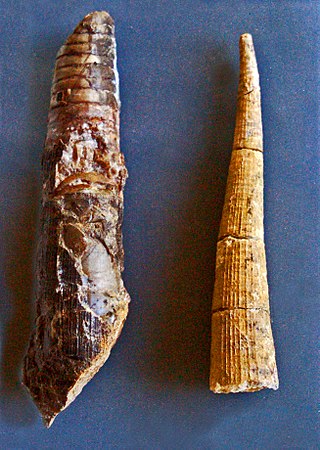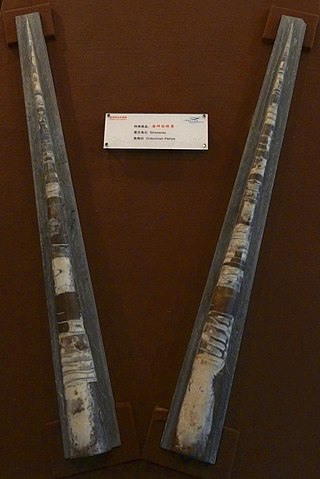Related Research Articles
Joseph John Sepkoski Jr. was a University of Chicago paleontologist. Sepkoski studied the fossil record and the diversity of life on Earth. Sepkoski and David Raup produced a new understanding of extinction events, by developing a statistical approach to the study of taxonomic diversification. He suggested that the extinction of dinosaurs 66 mya was part of a cycle of mass extinctions that may have occurred every 26 million years. But his most important contribution was the identification of the "Big 5" mass extinctions, events that have shaped the evolution of life on earth.
Jovellania is a genus of extinct prehistoric nautiloids from the order Oncocerida known from the Lower Devonian of Europe. Nautiloids form a broad group of shelled cephalopods that were once diverse and numerous but are now represented by only a handful of species in two genera.

Kionoceras is an extinct nautiloid cephalopod genus included in the orthocerid family Kionoceratidae with scattered worldwide distribution from the Middle Ordovician to the Lower Permian. Kionoceratids are orthocerids with prominent longitudinal ornamentation on their shells, sometimes augmented by secondary transverse ornamentation. Orthocerids are, of course, prehistoric nautiloides with generally straight and elongate shells, mostly with central or subcentral siphuncles.
Tetrapleuroceras is an extinct prehistoric nautiloid from the Lower Permian of the Urals in Russia. Nautilids are a type of nautiloid, a subclass of shelled cephalopods that were once diverse and numerous but now only represented by Nautilus and Allonautilus

Sinoceras is an extinct genus of nautiloids from China included in the family Orthoceratidae that lived from the middle Ordovician until the Devonian. The type species, S. chinense, was originally described as "Orthoceras chinense," but then was promoted by Shimizu and Obata to its own genus, Sinoceras, in 1935.
Stearoceras is an extinct genus of prehistoric nautiloids from the Lower Pennsylvanian - Lower Permian with a fair worldwide distribution.(Kümmel 1964)
Endorioceras is an extinct genus of actively mobile carnivorous cephalopod of the family Baltoceratidae that lived in what would be North America during the Ordovician from 490–479 mya, existing for approximately 11 million years.
Arionoceras is an extinct orthocerid genus from the Middle and Upper Silurian, of Europe that is estimated to have lived from 422.9 to 418.1 mya, existing for approximately 4.8 million years.
Bogoslovskya is an extinct orthoceroid cephalopod genus that lived in what is now Asia from the Devonian to the Permian.
Donacoceras is an extinct genus of actively mobile carnivorous cephalopod, essentially a Nautiloid that lived in what would be North America during the Ordovician from 460.5—443.7 mya, existing for approximately 16.8 million years.
Hemicosmorthoceras is an extinct genus of actively mobile carnivorous cephalopod, essentially a Nautiloid, that lived in what would be present day Europe during the Silurian to Devonian from 422.9—412.3 mya, existing for approximately 10.6 million years.
Leurocycloceras is an extinct genus of actively mobile carnivorous cephalopod, essentially a Nautiloid, that lived in what would be North America, Europe, and Asia during the Silurian from 443.7—418.7 mya, existing for approximately 25 million years.
Neosichuanoceras is an extinct genus of actively mobile carnivorous cephalopod, essentially a Nautiloid, that lived in what would be Asia during the Silurian from 436.0 to 428.2 mya, existing for approximately 7.8 million years.
Orthocycloceras is an extinct genus of actively mobile carnivorous cephalopods, essentially a Nautiloid, that lived in what would be Europe during the Silurian to Devonian from 428.2 to 412.3 mya, existing for approximately 15.9 million years.
Paradnatoceras is an extinct straight-shelled cephalopod genus that lived in what would become China during the Ordovician from 478.6 to about 461 mya, existing for approximately 17.6 Ma.
Parasphaerorthoceras is an extinct orthocerid genus, a nautiloid cephalopod, that lived in what would be Europe and north Africa during the Silurian from 422.9 to 418.1 mya, having existed for approximately 4.8 million years.
Protobactrites is an extinct nautiloid cephalopod belonging to the Orthoceratoidea that lived in what would be Europe and Asia during the Ordovician and Silurian from 466–421.3 mya, existing for approximately 44.7 million years.
Pseudotemperoceras is an extinct genus of nautiloid cephalopods belonging to the Orthocerida from the far eastern part of the Russian Federation that lived during the Triassic from 249.7 to 245 mya, existing for approximately 4.7 million years.
Vericeras is an extinct genus of nautiloid cephalopod that lived in what would be Europe during the Silurian from 421—418.7 mya, existing for approximately 2.3 million years.
Juresania is an extinct genus of brachiopod that existed from the Carboniferous to the Permian.
References
- ↑ PaleoBiology Database: Cryptocycloceras, basic info
- ↑ J. J. Sepkoski. 2002. A compendium of fossil marine animal genera. Bulletins of American Paleontology 363:1-560